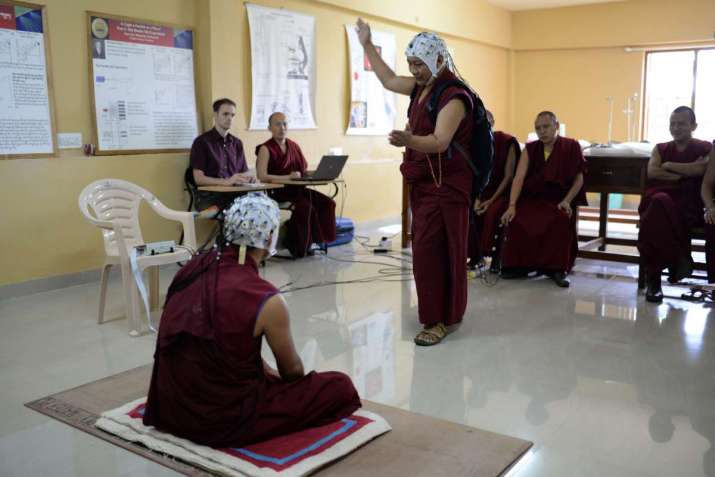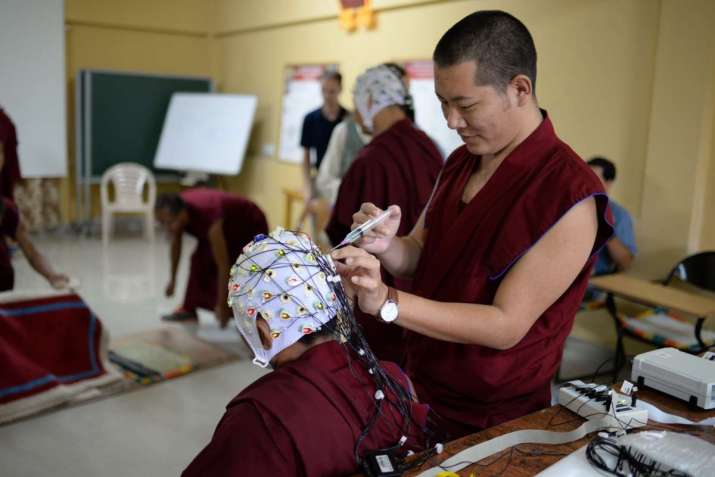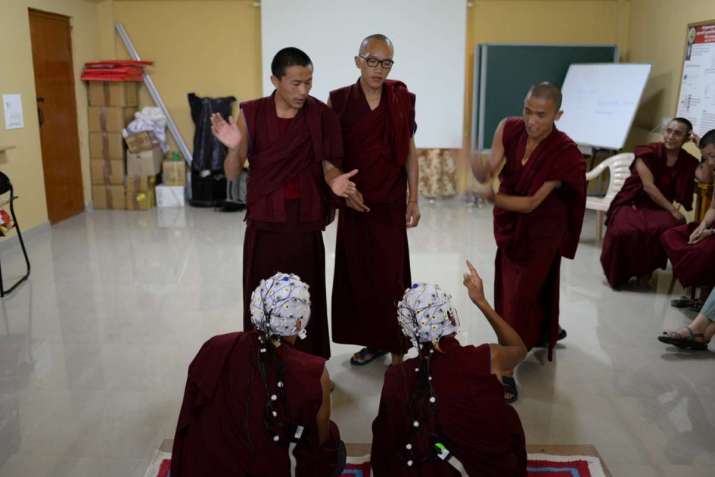NEWS
Researchers Measure Brain Activity of Monks During Monastic Debate
 Monks engaged in a debate while wearing white EEG caps. From scienceformonks.org
Monks engaged in a debate while wearing white EEG caps. From scienceformonks.orgA group of researchers from the Science for Monks project and Kent State University have been measuring the brain activity of Buddhist monks engaged in monastic debates. The research, which took place from 29 July–12 August at Sera Jey Monastic University in Bylakuppe, India, used electroencephalograph (EEG) technology to measure neural oscillation in the brain as the monks engaged in serious debates on topics ranging from emptiness to cosmology.
“We are here to map the brain activity of the Buddhist monks when they debate,” said Bryce Johnson, president and CEO of Science for Monks. “We want to understand what goes on in their brain and when the neurons synchronize.” (The Times of India)
Debating is a common activity for the monks—not merely an academic exercise, but a way to analyze the nature of reality. Ngawang Norbu, a member of the Sera Jay Science Centre, explained: “An important objective is to apply the knowledge to practical situations. His Holiness the Dalai Lama often emphasizes that mere learning is not as useful as practical applications of knowledge.” (The Times of India)
 A monk applies a conductive gel to the electrodes of the EEG cap. From scienceformonks.org
A monk applies a conductive gel to the electrodes of the EEG cap. From scienceformonks.orgDebating is a highly structured and stylized activity in Tibetan Buddhism, based on two roles or positions that the monks can take: there is a challenger, usually a more senior monk, who stands and asks questions, and a defender, usually a junior monk, who sits on the floor and tries to answer the questions posed to him by the challenger. The debates begin in a very civilized manner, but as they progress the challenger starts to use physical expressions of doubt: when he has caught an error of reasoning by the defender or wants to challenge an answer, he will stomp his left foot and clap his hands, signifying the meeting of compassion (right hand) and wisdom (left hand).
During the research, the monks were debating Buddhist theses as they normally would at the university, but with one difference; their usually clean-shaven heads were now covered with white electrode caps, which are part of the EEG equipment used to monitor their brain activity. EEG technology documents the repetitive activity of neurons, also known as neural oscillation, which is a “fundamental mechanism that enables the synchronization of neural activity within and across brain regions and promotes the precise coordination of neural processes underlying cognition, memory, perception, and behavior.” The neural oscillation is influenced by task constraints, such as attention. (ScienceDirect)
 Monks engaged in a debate. From scienceformonks.org
Monks engaged in a debate. From scienceformonks.orgAs David M. Fresco, professor of psychological sciences at Kent State University, observed, “The EEG captures the moments in the monks’ brains when they are engaged in debate. When do the neurons synchronize? What is the quality of attention during the course of the debate? If there is [neural] synchronization between the two monks, when does it occur? This is what we are finding out.” In addition, the research also examines the differences in the brain activity of junior and senior monks. (The Times of India)
The data gathered during the research has yet to be analyzed, but Johnson noted that the monks were very interested in participating in the research: “The monks see this as strengthening Buddhism. This is all part of the ancient Nalanda tradition,” he said. (The Times of India)
The project at Sera Jey Monastic University is an example of the research conducted by Science for Monks, an organization created in 2001 based on the Dalai Lama’s personal interest in science. Science for Monks seeks to introduce Western science and scientific education and dialogue to monastic education.
See more
Picking the brain of a monk: Where Buddhism claps its hands for science (The Times of India)
Neural Oscillation (ScienceDirect)
Science for Monks (Official Website)
Related news from Buddhistdoor Global
Nuns in Dharamsala Participate in Winter Debate before the Dalai Lama
Research Confirms the Health Benefits of Drum Meditation
Korean Researchers Claim Scientific Evidence for Meridians
Dalai Lama Commissions Website to Map Human Emotions
Dalai Lama Opens the First Session of the 30th Mind & Life Institute Dialogue
Psychologist Dr. Rick Hanson Examines the Science of Enlightenment
Related features from Buddhistdoor Global
Korea’s Great Buddhist-Confucian Debate – Book Review: The Most Influential Ideological Conflict in East Asian History
Science Meets Mind - Imagining a Revolution, with B. Alan Wallace
“Mindfulness Itself Has a Healing Property”: Venerable Analayo on Healing the Body and Mind
“Fertile Minds”– Encounters in the Tibetan Colony of Bir
Building Bridges: Researching the Efficacy of Religious Buddhist Practice at the University of Hong Kong














